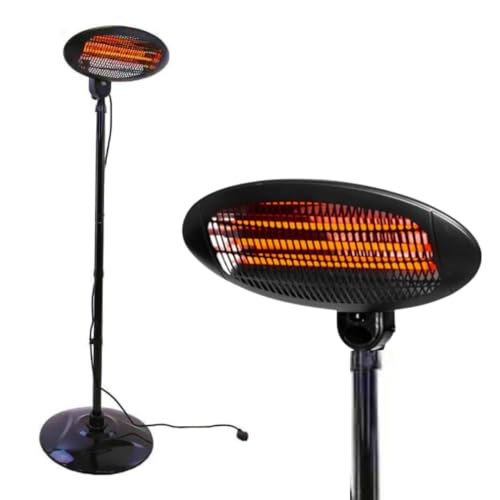
自己紹介
Choosing a Patio Heater Electric
For rooms that are designed with a desire to preserve a sleek, minimalist appearance electric patio heater heaters for walls are the way to go. They are simple to use and are less costly to run than propane models.
 patio heater electric free standing heaters, regardless of the type of fuel used must be kept away from fire-prone items and should not be left unattended. Check out these tips for safety on patio heaters for more details.
patio heater electric free standing heaters, regardless of the type of fuel used must be kept away from fire-prone items and should not be left unattended. Check out these tips for safety on patio heaters for more details.
How to Select the Best Heater
Outdoor living spaces are popular with Australian homeowners, with a lot of homeowners using their patios as a place to unwind, relax and unwinding. The cold temperatures, however, make it difficult to enjoy these spaces. Patio heaters provide efficient, targeted heating that can extend the usage of outdoor areas throughout the all-year. Choosing the right type of patio heater is essential to ensuring optimal performance safety, style, and security. When purchasing a heater, you should consider several factors, such as the installation requirements and fuel source.
Certain types of patio heaters, including ceiling-mounted and wall-mounted models require professional installation and are permanently fixed in the spot. Tabletop and freestanding heaters offer more flexibility. Portable electric patio heaters, for example, can be moved around your garden or yard to suit your needs. Some models have handles that make it easy to move. Certain electric patio heaters portable include remote controls to make operation easier.
When you are looking for a patio heater, take into consideration the size of your space and how many people will use it at one time. A large space requires more power than smaller ones, so you'll need to choose one that has enough power to provide sufficient heating. Similarly, you'll want to take into account the number of hours you intend to use the heater in a typical day, since this will determine the power consumption and the battery life of your device.
Depending on the kind of patio heater you select you'll also have to think about the fuel source. Electric patio heaters use electricity and don't release any emissions. Natural gas patio heaters, however, require your home to be plumbed with gas lines. Liquid propane heaters are easy to use and don't need any installation. However, the requirement for constant refueling is the reason they aren't the most cost-effective option.
Additionally, if you have children at home, who might touch the heater, it's crucial to select a model that has built-in safety features. Find an electric heater that automatically shuts off when it is tilted beyond a certain amount and also an alarm for flames to avoid accidental sparks. It is also possible to invest in an extinguisher in case of fire to keep on hand for emergencies.
Installation
A freestanding patio heater is the ideal way to extend your outdoor living space past the hottest months of the year. There are many kinds of patio heaters to choose from that include electric and gas-powered models. When buying an outdoor heater, it is important to think about the amount of the heat your patio requires and how much weight the heater can handle.
There are a few different ways to install a patio heater. The most popular method is with a ceiling-mounted heater. This option is perfect for patios that are covered since it doesn't sacrifice floor-space and ensures a uniform distribution of heat over the entire area.
This mounting option is available for all Bromic's Electric heaters. A variety of poles for ceiling mounting are available to match your style and to accommodate any ceiling height. If your room has a ceiling that is inclined the wedge that you put on the pole will allow the heater to be mounted perpendicularly on the floor while still complying with the minimum clearance requirements.
Wall mounting your patio heater is a great idea. It is possible to do this with an array of electric heaters. A variety of mounting brackets is available for each model. The brackets for our Platinum and Tungsten Electric heaters can be positioned at a 15 to 45 degree angle, varying according to the model in question that is 6 feet above ground and at least 5 feet from structures over the heater.
Propane: These heaters are powered by tanks of 20 pounds of propane that can be refilled at most gas stations and convenience stores. These heaters produce more heating than an electric heater, but they may require that the installation of a gas line. These heaters can be purchased as freestanding units or positioned on a structure like a fence, deck or pergola.
Some models come with adjustable heat settings. This is useful if you are hosting guests and they need a lower or higher level of warmth. Choose a propane patio heater with an arrestor that sparks. This will decrease the risk of fires caused by uncontrolled combustion.
Safety
Patio heaters can be ideal for extending your outdoor enjoyment and increase comfort. However, they can also create safety issues. This includes keeping the heater at least three feet away from any combustible material like furniture or potted plants. Also, it's recommended to place a protective mat under the heater, particularly for wooden decks.
The kind of heater as well as its fuel source will determine the precise safety guidelines to be followed. Propane gas patio heaters for example, can be more efficient in heating than electric models. However, they require regular refills of their tanks and can cause carbon monoxide to build up. It is also crucial to select models with features such as the anti-tilt switch as well as automatic shutoffs that minimize the possibility of a fire.
Aside from the types of heaters, how they are put in place and used will also affect their safety. While many patio heaters come with built-in safety measures it is best to follow the manufacturer's instructions to ensure maximum performance and security. Bromic offers a range of mounting options for heaters placed on the ceiling or wall. There are also longer mounting poles for hanging electric patio heater patio heaters, that will give you the ideal secure distance from walls and ceilings as well as fabrics like tablecloths and awnings.
To stop them from falling over, free-standing heaters need to be anchored or weighted. Strong winds can cause heaters to blow over or shift even when they are off, posing the risk of fire or injury. If you live in a region which is susceptible to frequent and thumping winds, think about using bungee cables or sandbags as anchors for your heaters on patios.
Whatever the type of fuel, it's recommended to keep an extinguisher for fire in case of in case of emergency. It is essential to select the appropriate class of extinguisher according to the fuel type of your heater (Class B for electric, Class C for gas, or a multipurpose for both). Don't let your heater run unattended. Accidents can happen.
Maintenance
Many problems with patio heaters occur due to improper use and maintenance practices. However, you can avoid most of these problems by following some basic usage and maintenance Best patio heater electric practices. Use a non-abrasive detergent to clean the heater as well as an air hose to the ventilation holes.
Do not use an extension cord with the patio heater. Connect the heater to an electrical outlet. An extension cord can overload circuits and cause electrical fires. It is also recommended to keep the heater away from combustible materials like curtains and wood.
You could have an issue with your propane patio heater is constantly shutting down. A professional should check the gas line at least once a yearly for clogs and leaks.
Propane patio heaters must be stored in a dry, cool space away from rain and wind. When storage is complete, disconnect the propane tank, and wrap it in a protective cover. When not in use, the heater should be placed in a ventilated space or under a canopy that is protected. This will help prevent corrosion and rust. It will also prevent it from tipping over.
職業
